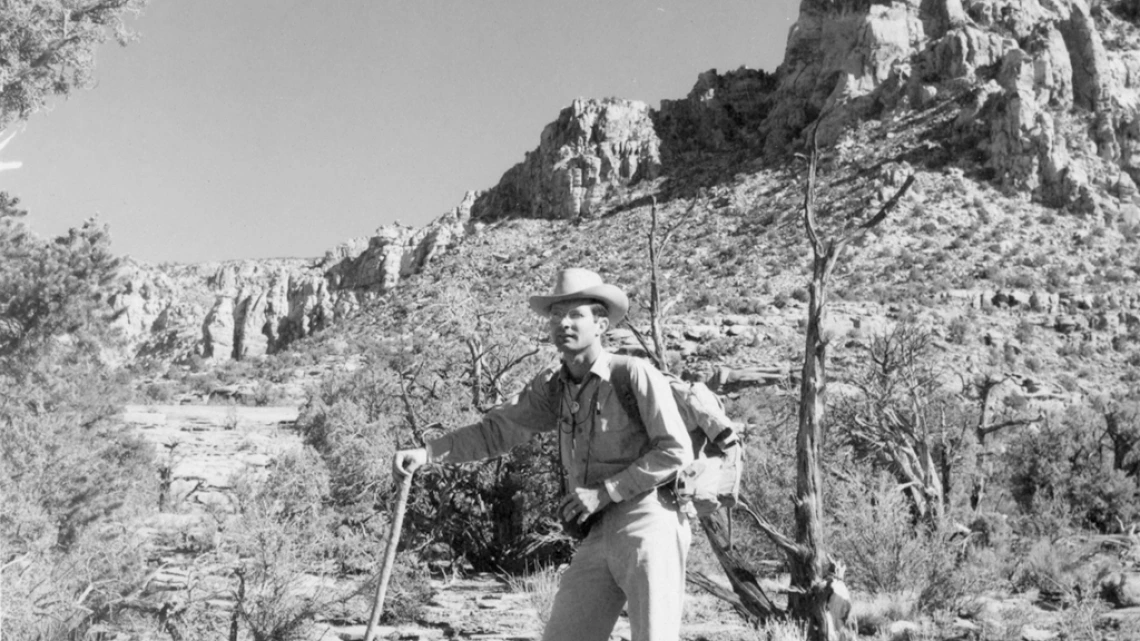Joe Carithers papers

Joe Carithers hiking to Rainbow Bridge National Monument as part of a Department of Interior survey of the monument and other sites in the Glen Canyon Dam region, 1960 (Box 4, Folder 1).
Collection area: Arizona and Southwest
Collection dates: 1909-2001 bulk (bulk 1958-1977)
The Joe Carithers papers document Carithers’ career as a conservationist and his involvement in national parks throughout the twentieth century. The papers contain ephemera, newspaper clippings, agendas, memoranda, correspondence, reports, photographs, personal objects, and books, many of which pertain to the Glen Canyon Dam, Lake Powell, conservation efforts aimed at Rainbow Bridge National Monument, the proposed Shrine of the Ages chapel, the founding of the Arizona State Parks Association, administration changes at the National Parks Association, and the creation of Saguaro National Monument. The papers also include a vial of water from Rainbow Bridge National Monument dated 1960. Some documents were acquired and retained by Carithers in the course of his work with the National Parks Service. Others were provided to Carithers by colleagues who worked elsewhere in conservation. The Joe Carithers papers do not contain documents related to Carithers’ employment with the City of Odessa, Texas.
Joseph Frank Carithers, Jr. (1926-2001) was as a conservationist in Southern Arizona and an advocate for the creation and maintenance of National Parks in the western United States. Carithers was born in Memphis, Tennessee to Joseph and Doris Carithers. In 1932, the Carithers family moved to Tucson, Arizona. Joseph Carithers, Sr. became superintendent of Tucson Mountain Park in 1937. Carithers attended Roskruge Junior High School and Tucson Senior High School, though he did not graduate from the latter.
In October 1944, Carithers enlisted in the United States Army and served in the Philippines and Japan until November 1946. Upon returning to Tucson, Carithers received his General Education Diploma and briefly attended the University of Arizona (1947-1948). In 1948, Joe Carithers married Hildegarde Meurer. Meurer had a daughter, Lynda Anne (1945), from her previous marriage. Carithers and Meurer had one son, Douglas Lee Carithers (1949).
Carithers succeeded his father as Superintendent of Tucson Mountain Park in 1949 and worked for the park until 1957. During these years, Carithers became involved in a number of regional conservation organizations including the Tucson Audubon Society (President, 1955-1957), Arizona Conservation Coordinating Committee, (Chairman, 1955), and the Desert Protective Council (Executive director, 1960). In 1956, Carithers co-founded the Arizona State Parks Association and was named temporary chairman of the organization. Arizona Governor Ernest W. McFarland awarded Carithers with a citation for, “outstanding leadership and service to the State of Arizona,” in 1957.
In April of 1957, Carithers accepted a position as Assistant Western Representative of the National Parks Association and his family relocated to Carmel Valley, California. Devereux Butcher (1907-1991), Carither’s long-time friend and colleague in the National Parks Association, left the Association in 1959 and founded National Wildlands News in Washington, D.C. Carithers was invited to join Butcher at National Wildlands News and the family relocated to Washington, D.C. in 1960.
Stewart Udall, United States Secretary of the Interior (1961-1969), named Carithers a Special Assistant to the Secretary in April of 1961. From 1962 through 1968, Carithers occupied a number of posts in the National Park Service, working from both the Regional Office in Santa Fe, New Mexico and Washington, D.C. Between 1968 and 1977, Carithers was posted to Canyonlands National Park and Big Bend National Park.
Joe Carithers believed strongly that sites of natural heritage should not be disturbed for manmade projects. In the 1950s and 1960s, he vocally opposed the Shrine of the Ages monument, designed by Harold E. Wagoner, within Grand Canyon National Park and proposed rifle ranges in Tucson Mountain Park. Carithers was also critical of the Glen Canyon Dam project which flooded a large area of Northern Arizona to create Lake Mead. Of particular concern was the fate of Rainbow Bridge National Monument which was within the projected flood zone. In the early 1960s, Carithers was also active as a proponent of the proposed Saguaro National Monument, now Saguaro National Park.
Throughout his life, Joe Carithers wrote poetry and essays which often reflected his appreciation for nature and public parks. He also took extensive photographs of park lands and drew illustrations of nature scenes.
Joseph Frank Carithers, Jr. died at his home in Roswell, New Mexico on June 20, 2001.
A collection guide explains what's in a collection. New to using our collections? Learn how to use a collection guide.
Collection guideAccess this collection
Visit us in person to access materials from this collection. Our materials are one-of-a-kind and require special care, so they can’t be checked out or taken home.
How to cite
Learn how to cite and use materials from Special Collections in your research.
